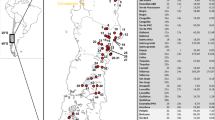Abstract
Charophytes are very common in Australian modern and Quaternary waterbodies, and are quite commonly incorrectly reported as “Chara” sp. or Lamprothamnium papulosum (Wallroth) Groves. This paper is the first attempt at the identification of the widespread euryhaline genus Lamprothamnium in Australia, and its use as a paleoenvironmental indicator. Lamprothamnium is distributed worldwide in all continents, except north and central America. The Australian environment, characterized by increasing aridity during the last 500 ka, has an abundance of saline lakes. We sampled 30 modern lakes and identified extant Lamprothamnium macropogon (A. Braun) Ophel and Lamprothamnium succinctum (A. Braun in Ascherson) Wood. Fossil gyrogonites, from lacustrine sediments ∼65 ka old from Madigan Gulf, Lake Eyre, were identified as Lamprothamnium williamsii sp. nov. We applied statistical analysis (analysis of variance, ANOVA) to the morphometry of the gyrogonites from one fossil and three living Lamprothamnium populations. The ANOVA test suggests all the populations are different, including two separate populations of extant L. macropogon, interpreted in this case as the expression of ecophenotypic variability. Lamprothamnium is a useful paleoenvironmental indicator because it indicates a non-marine environment with varying salinity ranging from fresh (usually 2–3 g l−1) to 70 g l−1, and water bodies holding water for at least 70 consecutive days. Collectively, these parameters provide important information in the study of ephemeral habitats.
Similar content being viewed by others
References
Bayly I.A.E. and Williams W.D. 1966. Chemical and biological studies on some saline lakes of southeast Australia. Aust. J. Mar. Freshwat. Res. 17: 177–228.
Braun A. 1843. Charae Preissianae Adiectis Reliquis Speciebus e Nova Hollandia Hucusque Cognitis. Linnea 17: 113–119.
Burne R.V., Bauld J. and De Deckker P. 1980. Saline lake charophytes and their geological significance. J. Sediment. Petrol. 50: 281–293.
Castel M. and Grambast L. 1969. Charophytes de L’Eocène des Corbières. Bull. Soc. Géol. Fr. 7: 936–943.
Chivas A.R., De Deckker P. and Shelley J.M.G. 1986. Magnesium content of non-marine ostracod shells: a new palaeosalinometer and palaeothermometer. Palaeogeogr. Palaeoclimatol. Palaeoecol. 54: 43–61.
Corillion R. 1957. Les Charophycées de France et d’Europe Occidentale. Reimp. Koeltz Verlag, Koenigstein-Taunus 1972, 499 pp.
Daily F.K. 1969. A Lamprothamnium succinctum (Characeae) with imperfect cortex. Bull. Torrey Bot. Club 96: 656–660.
Feist M. and Grambast-Fessard N. 1991. The genus concept in Charophyta: Evidence from Paleozoic to recent. In: Calcareous Algae and Stromatolites. Springer-Verlag, Berlin, pp. 189–203.
Garcia A. 1987. Estudio del gametangio femenino de Charophyta actuales de Argentina. Análisis comparado con el registro fósil correspondiente. Ph.D. Thesis, Universidad Nacional de La Plata, Argentina, 312 pp., 125 figures.
Garcia A. 1993. Quaternary and extant Lamprothamnium Groves from Argentina. Hydrobiologia 267: 143–154.
Garcia A. 1994. Charophytes: their use in paleolimnology. J. Paleolim. 10: 43–52.
Garcia A. 1996. Charophytes from Tom Thumbs Lagoon, Australia: An indicator of palaeoceanographic changes in the Holocene. Annual Meeting of IGCP-367, Sydney, pp. 22–23.
Garcia A. 1999a. Charophyte flora of South-eastern South Australia and South-western Victoria, Australia: Systematics, distribution and ecology. Aust. J. Bot. 47: 407–426.
Garcia A. 1999b. Quaternary charophytes from Salina del Bebedero, Argentina: their relation with extant taxa and paleolimnological significance. J. Paleolim. 21: 307–323.
Garcia A. and Chivas A.R. 1997. Pleistocene charophytes from Madigan Gulf, Lake Eyre, South Australia. In: Second International Symposium on Extant and Fossil Charophytes, Madison, USA, Abstracts, p. 17.
Garcia A. and Casanova M.T.C. 2003. Lamprothamnium heraldii sp. nov. (Charales, Charophyta) from Australia: The first dioecious representative of the genus. Phycologia 42: 622–628.
Garcia A., Jones B.G., Chenhall B.E. and Murray-Wallace C. 2002. Charophytes as environmental indicators: A Holocene example from Tom Thumbs Lagoon, Australia. Alcheringa 26: 507–518.
Groves J. and Allen G.O. 1935. A review of the Queensland Charophyta. Proc. Roy. Soc. Qld. 46: 34–59.
Guerlesquin M. 1992. Systématique et biogéographie du genre Lamprothamnium (Characées). Characteristique des biotopes aquatiques saumatres. Rev. Sci. l’eau 5: 415–430.
Horn af Rantzien H. 1959. Recent charophyte fructifications and their relations to fossil charophyte gyrogonites. Ark. för Bot. 4: 165–351.
Magee J.W., Bowler J.M., Miller G.H. and Williams D.L.G. 1995. Stratigraphy, sedimentology, chronology and palaeohy-drology of Quaternary lacustrine deposits at Madigan Gulf, Lake Eyre, South Australia. Palaeogeogr. Palaeoclimatol. Palaeoecol. 111: 3–42.
Ophel I.L. 1947. Notes on the genera Lychnothamnus and Lamprothamnium (Characeae). Trans. Roy. Soc. S. Aust. 71: 318–323.
Soulié-Märsche I. 1989. Etude comparée des gyrogonites des charophytes actuelles et fossiles et phylogénie des genres actuels. Ed. Rev. Ph.D. Thesis, Imprimerie des Tilleuls, Millau, France, 237 pp., 45 pl.
Soulié-Märsche I. 1991a. Charophytes as lacustrine biomarkers during the Quaternary in North Africa. J. Afr. E. Sci. 12: 341–351.
Soulié-Märsche I. 1991b. Flores de charophytes des paleolacs de la région de Taoudenni, s.l. In: Paléoenvironnements du Sahara. Lacs holocenes à Taoudenni (Mali)., Ed. Cent. Nat. Rech. Sci., pp. 165–172.
Soulié-Märsche I. 1999. Extant gyrogonite populations of Chara zeylanica and Chara haitiensis: Implications for taxonomy and palaeoecology. Aust. J. Bot. 47: 371–382.
van Raam J.C. 1995. The characeae of Tasmania. Nova Hedwigia 110: 1–80.
Wood R.D. 1962. New combinations and taxa in the revision of the Characeae. Taxon 11: 7–25.
Wood R.D. 1966. Characeae of New Caledonia. Rev. Algol. 815: 10–42.
Wood R.D. 1972. Characeae of Australia. Nova Hedwigia 22: 1–120.
Wood R.D. and Imahori K. 1964–1965. A revision of the Characeae Vol. I: Monograph, 902 pp. Vol. II: Iconograph, Cramer, Weinheim, 465 pp.
Wood R.D. and Mason R. 1977. Characeae of New Zealand. N. Z. J. Bot. 15: 87–180.
Zaneveld J.S. 1940. The Charophyta of Malaysia and adjacent countries. Blumea 4: 1–223.
Author information
Authors and Affiliations
Corresponding author
Rights and permissions
About this article
Cite this article
García, A., Chivas, A.R. Quaternary and extant euryhaline Lamprothamnium Groves (Charales) from Australia: Gyrogonite morphology and paleolimnological significance. J Paleolimnol 31, 321–341 (2004). https://doi.org/10.1023/B:JOPL.0000021725.32489.bd
Issue Date:
DOI: https://doi.org/10.1023/B:JOPL.0000021725.32489.bd




